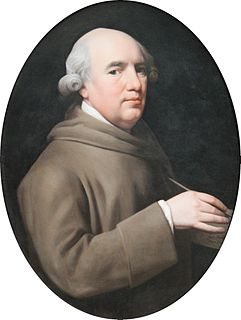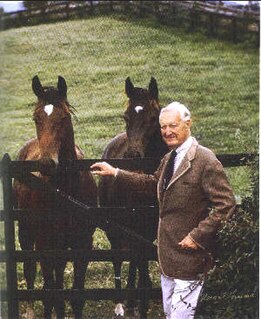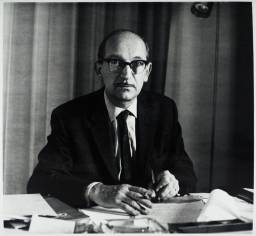Related Research Articles

Thomas Gainsborough was an English portrait and landscape painter, draughtsman, and printmaker. Along with his rival Sir Joshua Reynolds, he is considered one of the most important British artists of the second half of the 18th century. He painted quickly, and the works of his maturity are characterised by a light palette and easy strokes. Despite being a prolific portrait painter, Gainsborough gained greater satisfaction from his landscapes. He is credited as the originator of the 18th-century British landscape school. Gainsborough was a founding member of the Royal Academy.

George Stubbs was an English painter, best known for his paintings of horses. Self-trained, Stubbs learnt his skills independently from other great artists of the eighteenth century such as Reynolds or Gainsborough. Stubbs' output includes history paintings, but his greatest skill was in painting animals, perhaps influenced by his love and study of anatomy. His most famous painting, Whistlejacket, hangs in the National Gallery, London.

Paul Mellon was an American philanthropist and an owner/breeder of thoroughbred racehorses. He is one of only five people ever designated an "Exemplar of Racing" by the National Museum of Racing and Hall of Fame. He was co-heir to one of America's greatest business fortunes, derived from the Mellon Bank created by his grandfather Thomas Mellon, his father Andrew W. Mellon, and his father's brother Richard B. Mellon. In 1957, when Fortune prepared its first list of the wealthiest Americans, it estimated that Paul Mellon, his sister Ailsa Mellon-Bruce, and his cousins Sarah Mellon and Richard King Mellon, were all among the richest eight people in the United States, with fortunes of between 400 and 700 million dollars each.

The Yale Center for British Art at Yale University in downtown New Haven, Connecticut, houses the largest and most comprehensive collection of British art outside the United Kingdom. The collection of paintings, sculpture, drawings, prints, rare books, and manuscripts reflects the development of British art and culture from the Elizabethan period onward.

Sir Roy Colin Strong, is an English art historian, museum curator, writer, broadcaster and landscape designer. He has served as director of both the National Portrait Gallery and the Victoria and Albert Museum in London. Strong was knighted in 1982.
The Paul Mellon Centre for Studies in British Art is a scholarly centre in London devoted to supporting original research into the history of British Art. It was founded in 1970 and endowed by a gift from Paul Mellon. Since 1996, it has been situated at 16 Bedford Square in a Grade I listed building. This building houses an outstanding library of 26,000 publications focused on British art and architecture, and over 25 collected archives which include papers of eminent art historians such as Ellis K. Waterhouse, Oliver Millar, Brian Sewell and Brinsley Ford. It also holds the records of its own institutional archives, including a growing oral history collection. The centre compiled its own photographic archive from 1970-1996 and now also holds the Tate photographic archive. All of these research collections are available to consult in the Centre's Public Study Room.
Sir Oliver Nicholas Millar was a British art historian. He was an expert on 17th-century British painting, and a leading authority on Anthony van Dyck in particular. He served in the Royal Household for 41 years from 1947, becoming Surveyor of The Queen's Pictures in 1972. He was the first Director of the Royal Collection from 1987. He served in both offices until his retirement in 1988.
Sir Ellis Kirkham Waterhouse was an English art historian and museum director who specialised in Roman baroque and English painting. He was Director of the National Galleries of Scotland (1949–52) and held the Barber chair at Birmingham University until his official retirement in 1970.

The Soviet sale of Hermitage paintings in 1930 and 1931 resulted in the departure of some of the most valuable paintings from the collection of the State Hermitage Museum in Leningrad to Western museums. Several of the paintings had been in the Hermitage Collection since its creation by Empress Catherine the Great. About 250 paintings were sold, including masterpieces by Jan van Eyck, Titian, Rembrandt, Rubens, Raphael, and other important artists. Andrew Mellon donated the twenty-one paintings he purchased from the Hermitage to the United States government in 1937, which became the nucleus of the National Gallery of Art in Washington, D.C.
Martin Postle is a British art historian who is deputy director for collections and publications at the Paul Mellon Centre for Studies in British Art, London, and a leading expert on the art of Sir Joshua Reynolds. He is a former curator at the Tate Gallery.

Sir Norman Robert Reid was an arts administrator and painter. He served as the Director of the Tate Gallery from 1964 to 1979.
Tarnya Cooper is an art historian and author who is currently the National Trust's Curatorial & Collections Director.
Sir Christopher John White CVO FBA is a British art historian and curator. He is the son of the artist and art administrator Gabriel White. He has specialized in the study of Rembrandt and Dutch Golden Age painting and printmaking.
Professor Mark Hallett is an art historian specialising in the history of British art. He is currently Director of Studies at the Paul Mellon Centre for Studies in British Art.
John Anderson Stuart Ingamells was a British art historian, writer, and former director of the Wallace Collection.
Giles Waterfield was a British, McKitterick Prize winning novelist, art historian and curator.

Penelope Curtis is a British arts administrator, director of Lisbon's Museu Calouste Gulbenkian from 2015 to 2020, and director of Tate Britain from 2010 to 2015.

Arthur Graham Reynolds,, was an English art historian who was Keeper of Paintings at the Victoria and Albert Museum. He was a leading expert on portrait miniatures and the art of John Constable, for whose works he wrote the catalogue raisonné. Reynolds's approach exemplified traditional scholarship and connoisseurship and he was fiercely opposed to the New Art History of the 1970s.
Judith Emilie Egerton was an Australian-born British art historian and curator. She specialised in eighteenth-century British art and, particularly, the work of George Stubbs.
Vikki Slowe is a British printmaker and painter.
References
- ↑ "Brian Francis ALLEN - Personal Appointments". Companies House . Retrieved 2021-05-22.
- ↑ "Allen, Brian, 1952-". id.loc.gov. Retrieved January 6, 2021.
- ↑ THE PRIME MINISTER APPOINTS DR BRIAN ALLEN TO THE BOARD OF THE NATIONAL PORTRAIT GALLERY (PDF), Department for Culture, Media and Sport, July 2012, retrieved 11 July 2016
- ↑ Rosalie Jovanovic, "Mark Hallett to Be Director of Studies at Paul Mellon Centre", http://observer.com/2012/08/mark-hallett-to-be-director-of-studies-at-paul-mellon-centre, accessed 1 August 2012
- ↑ International Advisory Board, Ben Uri Gallery, http://benuri.org.uk/about-us/international-advisory-board/